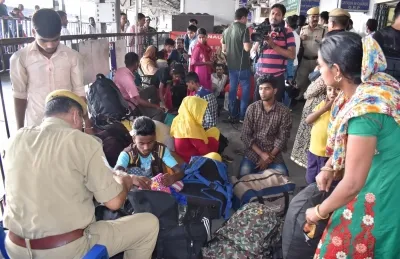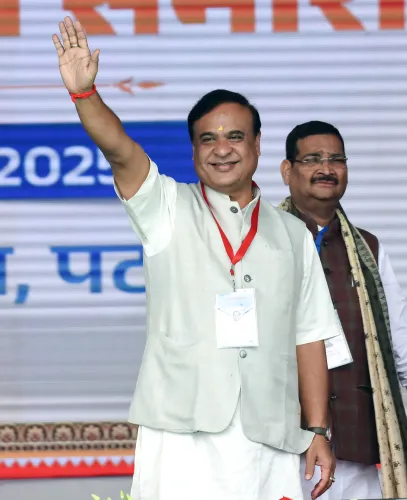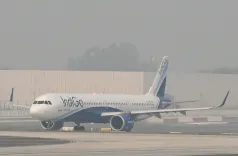What is the Bangladeshi Infiltration Crisis and Its Threats to India?

Synopsis
Key Takeaways
- Major source of illegal immigrants is Bangladesh.
- Security measures are being intensified at key entry points.
- Touts facilitate illegal immigration for profit.
- Legal loopholes create challenges in deportation processes.
- Governments are forming Special Task Forces to combat this issue.
New Delhi, Aug 11 (NationPress) Following Operation Sindoor, the Indian government has opted for rigorous measures against illegal immigrants from Pakistan, Bangladesh, and Myanmar. Reports from various state authorities show that the majority of unauthorized immigrants are from Bangladesh, trailed by Myanmar and Pakistan.
Security agencies have raised alarms about the increasing number of illegal migrants from Bangladesh, noting their significant impact on local demographics. A report compiled by these agencies details the methods utilized by these migrants.
The report outlines the routes and loopholes exploited over the years to evade deportation. Key entry points into India include Chapali, Malda, Murshidabad, 24 Paraganas, and Dineshpur. In light of this information, security has been intensified at these locations.
The escalating crisis in Bangladesh exacerbates the issue, prompting more individuals to attempt crossing into India.
In addition to tackling illegal migration, there is a significant crackdown on the touts who facilitate this process. These networks comprise between 50 to 100 agents across all states that receive these illegal migrants.
The primary role of a tout is to enable infiltration, while agents are responsible for securing employment and ensuring that these individuals return to the state from which they received their Aadhaar Card and Voter ID.
The majority of these identification documents are issued in West Bengal, Assam, Mizoram, and Bihar. Returning to these states during elections is compulsory; failure results in the withdrawal of their documents and potential deportation.
Touts charge anywhere from Rs 5,000 to Rs 7,000 for document assistance and frequently collaborate with certain administrative elements to streamline the process.
Before relocating to another state, depending on local demand, the migrants are instructed to claim they are from Assam. This has led to their widespread identification as Assam Labour across various states.
Additionally, they are advised to limit interactions with locals and remain together.
In Kerala, it has been observed that these Bangladeshi migrants often seek refuge in Bengali Colonies, where their dialect closely resembles that of the local population, aiding their integration.
Despite prior efforts to address this issue, many have discovered loopholes to circumvent the system. Notably, some individuals actually prefer being charged, as they can secure bail easily due to the courts not categorizing the offenses as severe.
Crowded jails also influence courts to prioritize other matters. Another legal loophole is that once a case is brought before the court, deportation is halted until the case concludes. These cases rank low on the court's agenda and often languish for years due to backlogs.
These factors complicate the deportation process. It has also been reported that many deported individuals eventually return to India, often obtaining new identities after initially remaining in their home country.
This situation is part of a broader conspiracy dating back to the post-Liberation War era. The ISI collaborated with Jamaat-e-Islami to orchestrate large-scale infiltrations into India, aiming to alter demographics, usurp local jobs, commit crimes, and instigate communal discord.
According to Amar Bhushan, a former member of the Research and Analysis Wing (R&AW), a nexus between the ISI and Bangladesh’s Directorate General of Forces Intelligence (DGFI) was highlighted by his agency in the 1990s. The intent was to utilize the Jamaat to execute this extensive infiltration to destabilize India.
With the current regime in Bangladesh fostering ties with Pakistan, this predicament is likely to escalate, he warns.
According to data from the NCRB, the highest rate of crimes committed by foreign nationals is attributed to Bangladeshis, accounting for 24.5%, with Nigerians at 5.5%, Nepalese at 3.3%, and Myanmarese at 2.3%.
Many state governments are now forming Special Task Forces to address this issue. The Tamil Nadu government has announced plans to establish a Special Task Force to deport undocumented Bangladeshis and Rohingyas. This initiative is part of a nationwide campaign launched by the Ministry of Home Affairs (MHA) aimed at identifying and deporting illegal immigrants.
The MHA recently instructed Chief Secretaries of all states to set up Special Task Forces under police supervision to detect and deport foreign nationals residing without valid travel documentation.









